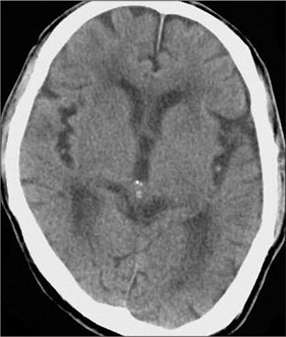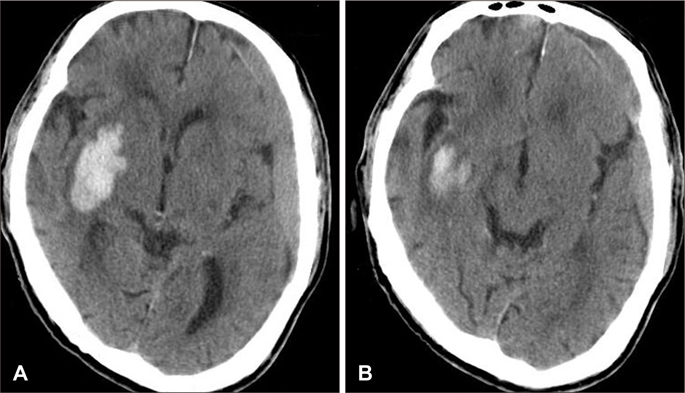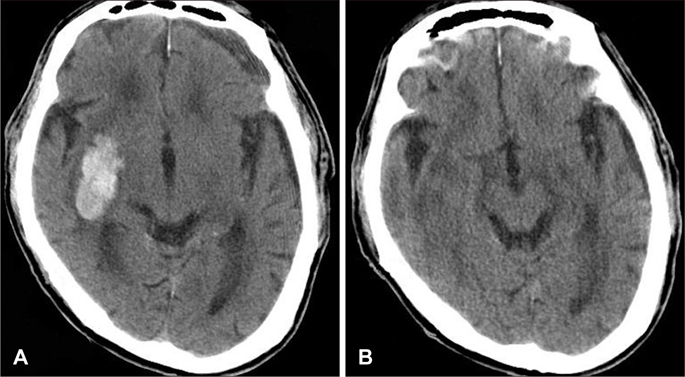J Korean Neurotraumatol Soc.
2011 Apr;7(1):43-46. 10.13004/jknts.2011.7.1.43.
Spontaneous Intracerebral Hemorrhage Occurring during Progression of Chronic Subdural Hematoma
- Affiliations
-
- 1Department of Neurosurgery, Chonnam National University Hospital & Medical School, Gwangju, Korea. jkl@chonnam.ac.kr
- 2The Brain Korea 21 Project, Center for Biomedical Human Resources at Chonnam National University, Gwangju, Korea.
- KMID: 1427653
- DOI: http://doi.org/10.13004/jknts.2011.7.1.43
Abstract
- Spontaneous intracerbral hemorrhage (SICH) and chronic subdural hematoma (CSDH) represent the most common types of intracranial hematoma. However, SICH during the progression of CSDH is a very rare disease entity due to etiologic differences. The purpose of this report is to alert neurosurgeons to the existence of this condition and to consider possible mechanisms. An 87-year-old man presented with a sudden onset of headache, followed by quadriparesis. Brain computed tomography scan revealed CSDH in the left hemisphere and remote SICH in the right basal ganglia. CSDH was treated with burr hole drainage, however, the deep parenchymal hematoma was treated conservatively. The patient had a progressive recovery with a good outcome. We recently experienced a case of SICH that occurred during the progression of CSDH. To our knowledge, this is the first reported case of SICH occurring during the progression of CSDH.
MeSH Terms
Figure
Reference
-
1. Akhaddar A, Ajja A, Elmostarchid B, Boucetta M. Combined epidural and intracerebral hematomas after evacuation of bilateral chronic subdural hematoma. Neurochirurgie. 2008; 54:728–730.
Article2. Avezaat CJ, van Eijndhoven JH, Wyper DJ. Cerebrospinal fluid pulse pressure and intracranial volume-pressure relationships. J Neurol Neurosurg Psychiatry. 1979; 42:687–700.
Article3. Chang SH, Yang SH, Son BC, Lee SW. Cerebellar hemorrhage after burr hole drainage of supratentorial chronic subdural hematoma. J Korean Neurosurg Soc. 2009; 46:592–595.
Article4. d'Avella D, De Blasi F, Rotilio A, Pensabene V, Pandolfo N. Intracerebral hematoma following evacuation of chronic subdural hematomas. Report of two cases. J Neurosurg. 1986; 65:710–712.5. Dinc C, Iplikcioglu AC, Bikmaz K, Navruz Y. Intracerebral haemorrhage occurring at remote site following evacuation of chronic subdural haematoma. Acta Neurochir (Wien). 2008; 150:497–499. discussion 499.
Article6. Douglas MA, Haerer AF. Long-term prognosis of hypertensive intracerebral hemorrhage. Stroke. 1982; 13:488–491.
Article7. Harbaugh RE, Schlusselberg DS, Jeffery R, Hayden S, Cromwell LD, Pluta D. Three-dimensional computerized tomography angiography in the diagnosis of cerebrovascular disease. J Neurosurg. 1992; 76:408–414.
Article8. Hirakawa T, Tanaka A, Yoshinaga S, Ohkawa M, Tomonaga M. Calcified chronic subdural hematoma with intracerebral rupture forming a subcortical hematoma. A case report. Surg Neurol. 1989; 32:51–55.9. Marmarou A, Shulman K, Rosende RM. A nonlinear analysis of the cerebrospinal fluid system and intracranial pressure dynamics. J Neurosurg. 1978; 48:332–344.
Article10. Miyazaki T, Matsumoto Y, Ohta F, Daisu M, Moritake K. A case of unknown origin subarachnoid hemorrhage immediately following drainage for chronic subdural hematoma. Kurume Med J. 2004; 51:163–167.
Article11. Modesti LM, Hodge CJ, Barnwell ML. Intracerebral hematoma after evacuation of chronic extracerebral fluid collections. Neurosurgery. 1982; 10:689–693.
Article12. Patel PV, FitzMaurice E, Nandigam RN, Auluck P, Viswanathan A, Goldstein JN, et al. Association of subdural hematoma with increased mortality in lobar intracerebral hemorrhage. Arch Neurol. 2009; 66:79–84.
Article13. Sousa J, Golash A, Vaz J, Chaudhary H. Spontaneous intracerebral haemorrhage following evacuation of chronic subdural hematomas. J Clin Neurosci. 2004; 11:794–796.
Article14. Stefini R, Ghitti F, Bergomi R, Catenacci E, Latronico N, Mortini P. Uncommon presentation of ruptured intracranial aneurysm during surgical evacuation of chronic subdural hematoma: case report. Surg Neurol. 2008; 69:89–92. discussion 92.
Article15. Tabaddor K, Shulmon K. Definitive treatment of chronic subdural hematoma by twist-drill craniostomy and closed-system drainage. J Neurosurg. 1977; 46:220–226.
Article16. Vogels RL, Verstegen MJ, van Furth WR. Cerebellar haemorrhage after non-traumatic evacuation of supratentorial chronic subdural haematoma: report of two cases. Acta Neurochir (Wien). 2006; 148:993–996.
Article
- Full Text Links
- Actions
-
Cited
- CITED
-
- Close
- Share
- Similar articles
-
- Spontaneous Spinal Subdural and Subarachnoid Hemorrhage with Concomitant Intracerebral Hemorrhage: A Case Report
- "Contralateral" Acute Subdural and Intracerebral Hemorrhage Occurring Simultaneously after Evacuation of Huge Chronic Subdural Hematoma
- Inteacerebral and Brain Stem Hemorrhage Following Evacuation of Chronic Subdural Hematoma and Hygroma
- Arachnoid Cyst with Spontaneous Intracystic Hemorrhage and Chronic Subdural Hematoma
- Usefulness of Middle Meningeal Embolization to Prevent Recurrent Spontaneous Chronic Subdural Hemorrhage




